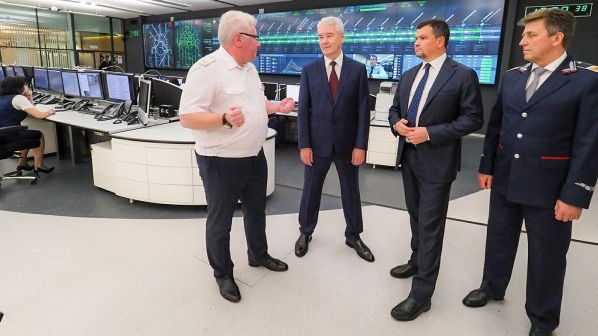The EDC was created under the Digital Subway programme, which was launched in 2013 and is currently 65% complete.
The centre incorporates traffic management along with management of electromechanical equipment and escalators, which were located on Prospekt Mira, the electrical service and situational centre, previously based on Gilyarovskogo Street, and power supply control, previously based on Bolshaya Nikitskaya Street.
“With an increase in passenger traffic, which reaches 700,000 passengers in the evening peak period, the number of trains in operation will increase to 682 units,” says Moscow Metro’s chief dispatcher, Mr Andrey Zhabin. “And of course, managing so many trains and all that infrastructure, including more than 900 escalators, is much more efficient from a single centre.”
Information on the operation of all metro lines and the Moscow Central Ring (MCC) is incorporated into the single building, with the future 430km Moscow Central Diameter suburban network, the first two lines of which are due to open next year, and other suburban lines also due to be managed from the centre when they open.
About 800 staff from dispatchers to media managers will be based in the EDC.
Traffic controllers and infrastructure managers for each line will share a room, allowing them to exchange information quickly and make decisions, with the Lublin - Dmitrov line the first to be managed from the centre.
Digitalisation
Before the opening of the EDC, the Moscow metro primarily operated in analogue mode, with dispatchers contacting each other by phone. An internal communications officer would report a problem or incident, and through a series of calls, the information would be passed to the dispatchers on duty who would make the necessary decisions before informing the management and network. The digitalisation of the system will increase the speed of response to emergency situations and make the metro more reliable for passengers.
The data transmitted from the different metro systems in real-time is displayed on a video wall consisting of 36 monitors. In normal mode, these display the general status of the metro, including the timetable, the number of passengers and other indicators.
EDC employees can monitor the operation of all the main elements of the metro infrastructure such as train location, system status and the condition of various systems.
In the event of an incident, dispatchers will see a two-way metro line diagram, information from the main CCTV cameras, and data on current speed limits, along with incoming messages from internal and external information sources, a mnemonic diagram of the station with the location of the incident, and, if necessary, a city map.
The EDC has a decision support system which is already programmed with around 100 scenarios and can provide dispatchers with an optimal procedure in case of an incident.
“It is not enough to build a large number of stations and lines, it is also important to manage this network efficiently,” says Moscow mayor Mr Sergei Sobyanin, who attended the opening ceremony. “Such a metro control centre, which has been opened today and will gradually be filled with life throughout the year, is, of course, a big step in the development in terms of managing traffic quality, punctuality, regulatory procedures, safety, and the quick resolution of emergency situations.”
For more information metro and commuter rail projects in Russia, subscribe to IRJ Pro.

